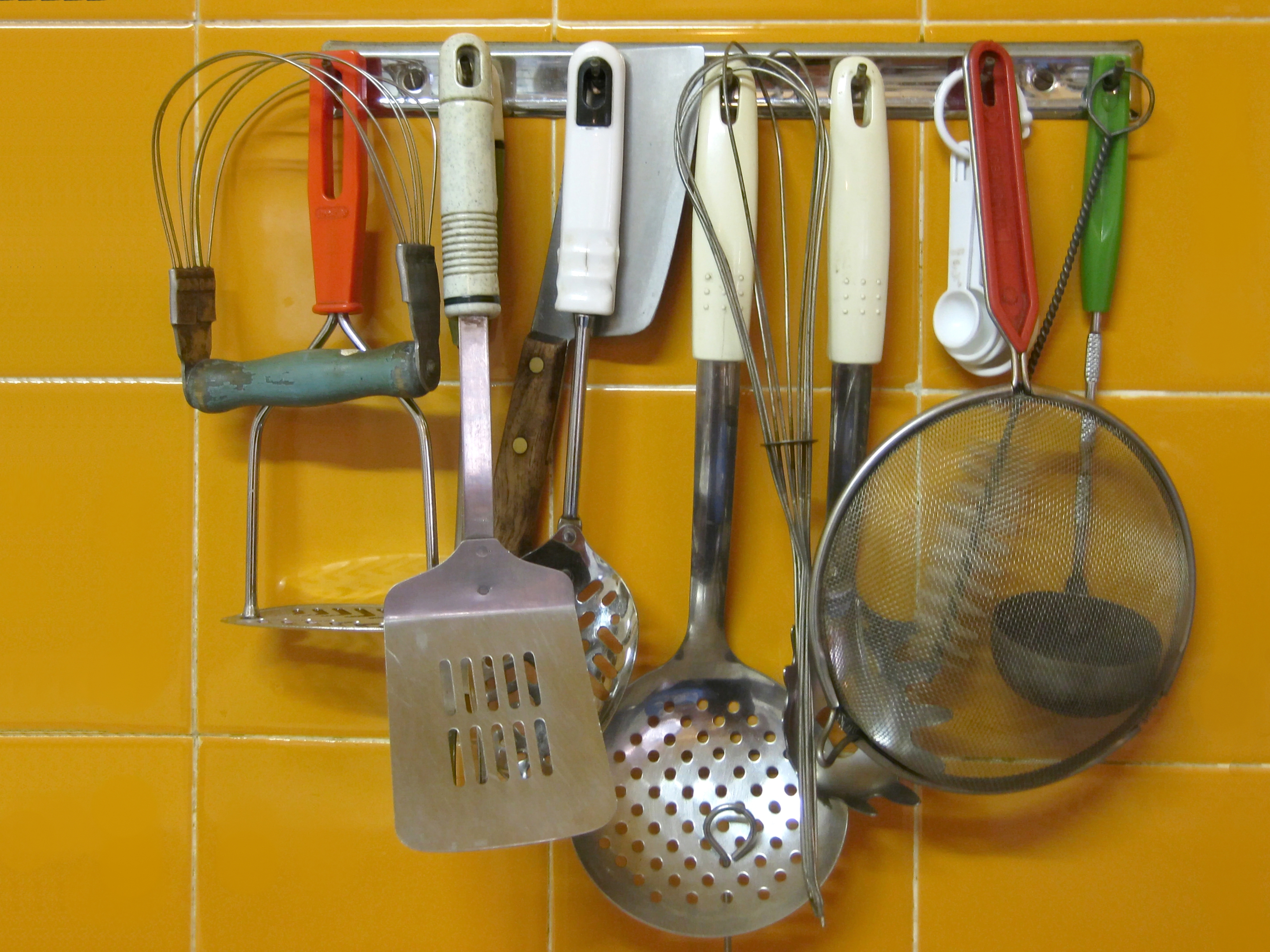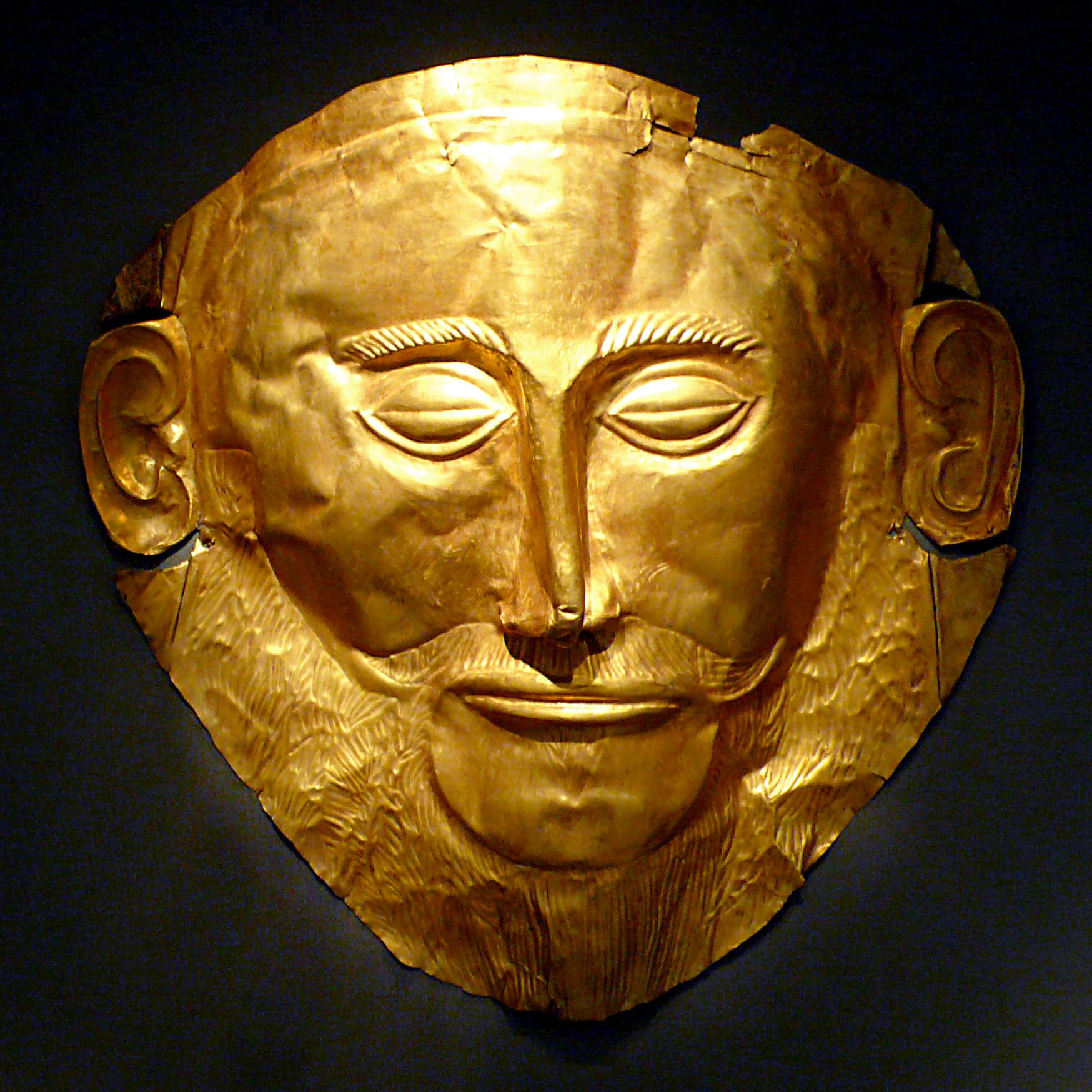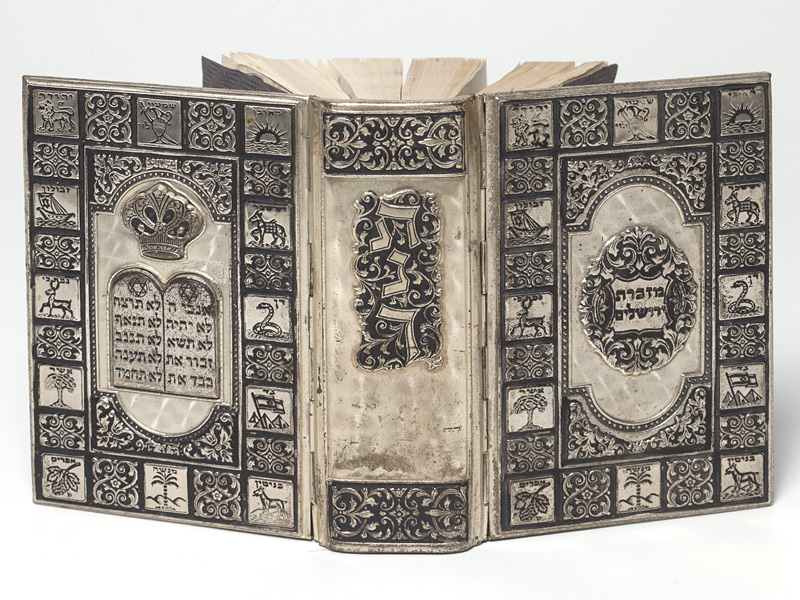|
Flesh-hook
270px, The Dunaverney flesh-hook, Bronze Age Ireland Flesh-hook is a term for a variety of archaeological artifacts which have metal hooks and a long handle, or socket for a lost wooden handle. Though the term may be applied to objects from other times and places, it is especially associated with the European Bronze Age and Iron Age. The metal shaft divides to form between two and five hooks with some sort of sharpened end. The purposes of the objects probably include pulling meat out of a pot or hides out of tan-pits. Some are plain in design but many are elaborately decorated, and if related to food, are clearly for the feasting hall rather than the kitchen (if such a distinction existed); some have been found with cauldrons and other large vessels. Some Bronze Age types are regarded as ritual objects, perhaps never actually used for a practical purpose. The division and serving of meat at feasts and after sacrifices was a matter of great social significance, and some tens ... [...More Info...] [...Related Items...] OR: [Wikipedia] [Google] [Baidu] |
Dunaverney Flesh-hook
The Dunaverney Flesh-Hook is a sophisticated bronze artefact from Prehistoric Ireland, thought to be an item of ceremonial feasting gear, and a symbol of authority. It is believed it was used to remove chunks of meat from a stew in a large cauldron for serving. It dates to the Late Bronze Age, between 1050 and 900 BC. Since 1856, it has been in the British Museum in London. Description Along the top of the flesh-hook are five birds, two large ones next to three smaller ones. At the bottom of the shaft, facing the family of five, are two birds. The group of two birds, presumably an adult pair, can be identified as corvids, perhaps ravens, the family of five as swans and Cygnet (bird), cygnets. The two sets of birds seem to invoke opposites: birds of water versus birds of the air; white ranged against black, fecundity as opposed to death (implied by the predatory character of ravens). Perhaps, in the mind of the Bronze Age inhabitants, the two sets of birds denoted a fable of oppos ... [...More Info...] [...Related Items...] OR: [Wikipedia] [Google] [Baidu] |
Iron Age
The Iron Age is the final epoch of the three-age division of the prehistory and protohistory of humanity. It was preceded by the Stone Age (Paleolithic, Mesolithic, Neolithic) and the Bronze Age (Chalcolithic). The concept has been mostly applied to Iron Age Europe and the Ancient Near East, but also, by analogy, to other parts of the Old World. The duration of the Iron Age varies depending on the region under consideration. It is defined by archaeological convention. The "Iron Age" begins locally when the production of iron or steel has advanced to the point where iron tools and weapons replace their bronze equivalents in common use. In the Ancient Near East, this transition took place in the wake of the Bronze Age collapse, in the 12th century BC. The technology soon spread throughout the Mediterranean Basin region and to South Asia (Iron Age in India) between the 12th and 11th century BC. Its further spread to Central Asia, Eastern Europe, and Central Europe is somewhat dela ... [...More Info...] [...Related Items...] OR: [Wikipedia] [Google] [Baidu] |
Food Preparation Utensils
A kitchen utensil is a hand-held, typically small tool that is designed for food-related functions. Food preparation utensils are a specific type of kitchen utensil, designed for use in the preparation of food. Some utensils are both food preparation utensils and eating utensils; for instance some implements of cutlery – especially knives – can be used for both food preparation in a kitchen and as eating utensils when dining (though most types of knives used in kitchens are unsuitable for use on the dining table). In the Western world, utensil invention accelerated in the 19th and 20th centuries. It was fuelled in part by the emergence of technologies such as the kitchen stove and refrigerator, but also by a desire to save time in the kitchen, in response to the demands of modern lifestyles. [...More Info...] [...Related Items...] OR: [Wikipedia] [Google] [Baidu] |
Oxford English Dictionary
The ''Oxford English Dictionary'' (''OED'') is the first and foundational historical dictionary of the English language, published by Oxford University Press (OUP). It traces the historical development of the English language, providing a comprehensive resource to scholars and academic researchers, as well as describing usage in its many variations throughout the world. Work began on the dictionary in 1857, but it was only in 1884 that it began to be published in unbound fascicles as work continued on the project, under the name of ''A New English Dictionary on Historical Principles; Founded Mainly on the Materials Collected by The Philological Society''. In 1895, the title ''The Oxford English Dictionary'' was first used unofficially on the covers of the series, and in 1928 the full dictionary was republished in 10 bound volumes. In 1933, the title ''The Oxford English Dictionary'' fully replaced the former name in all occurrences in its reprinting as 12 volumes with a one-v ... [...More Info...] [...Related Items...] OR: [Wikipedia] [Google] [Baidu] |
Cambridgeshire
Cambridgeshire (abbreviated Cambs.) is a Counties of England, county in the East of England, bordering Lincolnshire to the north, Norfolk to the north-east, Suffolk to the east, Essex and Hertfordshire to the south, and Bedfordshire and Northamptonshire to the west. The city of Cambridge is the county town. Following the Local Government Act 1972 restructuring, modern Cambridgeshire was formed in 1974 through the amalgamation of two administrative counties: Cambridgeshire and Isle of Ely, comprising the Historic counties of England, historic county of Cambridgeshire (including the Isle of Ely); and Huntingdon and Peterborough, comprising the historic county of Huntingdonshire and the Soke of Peterborough, historically part of Northamptonshire. Cambridgeshire contains most of the region known as Silicon Fen. The county is now divided between Cambridgeshire County Council and Peterborough City Council, which since 1998 has formed a separate Unitary authorities of England, unita ... [...More Info...] [...Related Items...] OR: [Wikipedia] [Google] [Baidu] |
Little Thetford Flesh-hook
The Little Thetford flesh-hook is a late Bronze-Age (1150950 BC) artefact discovered in 1929 in Little Thetford, near Ely, Cambridgeshire, England. A flesh-hook is a metal hook with a long handle used to pull meat out of a pot or hides out of tan-pits. This particular find is one of 32 other such archaeologically significant finds, scatters, and excavations within of Little Thetford. Discovery The artefact was found by a Mr. Dresser, whilst digging a ditch on reclaimed fenland, at Little Thetford in 1929. Discovered about down, it consisted of two-parts, connected by the remains of a wooden shaft. The wood remains have not survived; a contemporary wooden shaft has been added by the British Museum for display purposes. The artefact is in the British Museum though is not, as of 2012, on display. Within of Little Thetford, there have been 33 finds of various kinds over the years, such as flints from the Neolithic era through to a windmill of the late Medieval period. U ... [...More Info...] [...Related Items...] OR: [Wikipedia] [Google] [Baidu] |
Northern Ireland
Northern Ireland ( ga, Tuaisceart Éireann ; sco, label= Ulster-Scots, Norlin Airlann) is a part of the United Kingdom, situated in the north-east of the island of Ireland, that is variously described as a country, province or region. Northern Ireland shares an open border to the south and west with the Republic of Ireland. In 2021, its population was 1,903,100, making up about 27% of Ireland's population and about 3% of the UK's population. The Northern Ireland Assembly (colloquially referred to as Stormont after its location), established by the Northern Ireland Act 1998, holds responsibility for a range of devolved policy matters, while other areas are reserved for the UK Government. Northern Ireland cooperates with the Republic of Ireland in several areas. Northern Ireland was created in May 1921, when Ireland was partitioned by the Government of Ireland Act 1920, creating a devolved government for the six northeastern counties. As was intended, Northern Ireland ... [...More Info...] [...Related Items...] OR: [Wikipedia] [Google] [Baidu] |
County Antrim
County Antrim (named after the town of Antrim, ) is one of six counties of Northern Ireland and one of the thirty-two counties of Ireland. Adjoined to the north-east shore of Lough Neagh, the county covers an area of and has a population of about 618,000. County Antrim has a population density of 203 people per square kilometre or 526 people per square mile. It is also one of the thirty-two traditional counties of Ireland, as well as part of the historic province of Ulster. The Glens of Antrim offer isolated rugged landscapes, the Giant's Causeway is a unique landscape and a UNESCO World Heritage Site, Bushmills produces whiskey, and Portrush is a popular seaside resort and night-life area. The majority of Belfast, the capital city of Northern Ireland, is in County Antrim, with the remainder being in County Down. According to the 2001 census, it is currently one of only two counties of the Island of Ireland in which a majority of the population are from a Protestant back ... [...More Info...] [...Related Items...] OR: [Wikipedia] [Google] [Baidu] |
Atlantic Bronze Age
The Atlantic Bronze Age is a cultural complex of the Bronze Age period in Prehistoric Europe of approximately 1300–700 BC that includes different cultures in Britain, France, Ireland, Portugal, and Spain. Trade The Atlantic Bronze Age is marked by economic and cultural exchange that led to the high degree of cultural similarity exhibited by the coastal communities from Central Portugal to Galicia, Armorica, Cornwall and Scotland, including the frequent use of stones as chevaux-de-frise, the establishment of cliff castles, or the domestic architecture sometimes characterized by the roundhouses. Commercial contacts extended from Sweden and Denmark to the Mediterranean. The period was defined by a number of distinct regional centres of metal production, unified by a regular maritime exchange of some of their products. The major centres were southern England and Ireland, north-western France, and western Iberia. The items related to this culture are frequently found form ... [...More Info...] [...Related Items...] OR: [Wikipedia] [Google] [Baidu] |
European Bronze Age
The European Bronze Age is characterized by bronze artifacts and the use of bronze implements. The regional Bronze Age succeeds the Neolithic and Copper Age and is followed by the Iron Age. It starts with the Aegean Bronze Age in 3200 BC (succeeded by the Beaker culture), and spans the entire 2nd millennium BC ( Unetice culture, Tumulus culture, Nordic Bronze Age, Terramare culture, Urnfield culture and Lusatian culture) in Northern Europe, lasting until c. 600 BC. History Aegean The Aegean Bronze Age begins around 3200 BC when civilizations first established a far-ranging trade network. This network imported tin and charcoal to Cyprus, where copper was mined and alloyed with the tin to produce bronze. Bronze objects were then exported far and wide and supported the trade. Isotopic analysis of the tin in some Mediterranean bronze objects indicates it came from as far away as Great Britain. Knowledge of navigation was well developed at this time and reached a peak o ... [...More Info...] [...Related Items...] OR: [Wikipedia] [Google] [Baidu] |
Old Testament
The Old Testament (often abbreviated OT) is the first division of the Christian biblical canon, which is based primarily upon the 24 books of the Hebrew Bible or Tanakh, a collection of ancient religious Hebrew writings by the Israelites. The second division of Christian Bibles is the New Testament, written in the Koine Greek language. The Old Testament consists of many distinct books by various authors produced over a period of centuries. Christians traditionally divide the Old Testament into four sections: the first five books or Pentateuch (corresponds to the Jewish Torah); the history books telling the history of the Israelites, from their conquest of Canaan to their defeat and exile in Babylon; the poetic and " Wisdom books" dealing, in various forms, with questions of good and evil in the world; and the books of the biblical prophets, warning of the consequences of turning away from God. The books that compose the Old Testament canon and their order and names differ b ... [...More Info...] [...Related Items...] OR: [Wikipedia] [Google] [Baidu] |
Hebrew Bible
The Hebrew Bible or Tanakh (;"Tanach" ''Random House Webster's Unabridged Dictionary''. Hebrew: ''Tānāḵh''), also known in Hebrew as Miqra (; Hebrew: ''Mīqrā''), is the Biblical canon, canonical collection of Hebrew language, Hebrew scriptures, including the Torah, the Nevi'im, and the Ketuvim. Different branches of Judaism and Samaritanism have maintained different versions of the canon, including the 3rd-century Septuagint text used by Second-Temple Judaism, the Syriac language Peshitta, the Samaritan Torah, the Dead Sea Scrolls, and most recently the 10th century medieval Masoretic Text, Masoretic text created by the Masoretes currently used in modern Rabbinic Judaism. The terms "Hebrew Bible" or "Hebrew Canon" are frequently confused with the Masoretic text, however, this is a medieval version and one of several ... [...More Info...] [...Related Items...] OR: [Wikipedia] [Google] [Baidu] |





